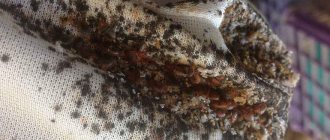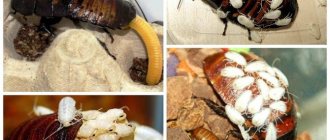How long do bed bugs live without food and human blood in an empty apartment, what is the life expectancy of bed bug larvae, how durable are bed bug eggs? This is a topic important for the development of innovative technologies and new methods of exterminating bed bugs.
A feeding bug can live from 300 to 485 days, depending on the species.
However, bed bugs in the home do not tend to live without humans for so long. This is due to the temperature. The warmer the climate, the faster they can reproduce; once they reproduce and lay eggs, the life cycle is near the end. Therefore, the typical life cycle of a bed bug is about 4 and a half months.
Bed bugs reproduce extremely quickly. They lay five to eight eggs per week for 18 weeks.
Their life cycle varies, usually depending on temperature, but the eggs will hatch in about ten days. After two months they will be ready to breed again. You can imagine how quickly their population can accelerate in warm weather when their life cycle is even shorter.
Feeding features of bedbugs
Feeding on human blood, bedbugs and their offspring prefer to be in maximum proximity to the food item, so they settle right in the bed. For a bedbug, the best period of wakefulness and eating is from three in the morning to eight in the morning, when a person enters the deep sleep phase. Having drunk blood and been satiated, the parasites hide, multiply and rest during the daytime.
Female bed bugs drink blood the most; they need it to reproduce new offspring. A sleeping and immobilized person makes it possible to drink blood without hindrance.
When a bug bites, it injects a substance under the human skin with properties similar to anesthesia. The analgesic effect lasts about 10 minutes, during which time the bug has time to drink blood and move to another part of the body. After satiation, the parasite does not feel hungry for a week.
For bed pests to live a full life, food plays an important role. Full reproduction and rapid maturation of individuals is impossible without a sufficient volume of blood consumed.
There is one interesting detail: if there is a man and a woman in bed, the bug will give preference to the female sex. A small child in the house will become the main source of food, since his skin is very soft and thin, so it will not be a problem for the bug to bite through it.
Habitat of bedbugs
Bedbugs do not have wings, and do not move quickly on any object - up to 90-100 cm per minute. Scientists claim that these insects are able not only to sense the smell and warmth of the human body, but also the pulsation of blood in their cardiovascular system. Therefore, his shelters are located in close proximity to the sleeping place of a person or animal:
- Beds, sofas, and mattresses are the main places where bedbugs live.
- In bedside furniture, rugs, any paintings or other decorative items hanging above beds, in clocks or shelves.
- In any cracks in the floor or walls near a person’s sleeping places.
These insects can live in blankets, blankets or pillows. That’s why this type of “harmful” parasite is called bed bugs.
Bedbugs do not nest directly in sheets or duvet covers, because by moving in a dream a person can crush them. These insects try to remain unnoticed, so they crawl out of their shelters only in search of food.
You can often find bedbugs in the space between the pillowcase and the contents of the pillow. They do not live in such a filler, because it is difficult for them to move and breathe there.
Occasionally, bedbugs leave their nests in places where there is a place for a pet. But more often, bedbugs settle in the cages of parrots or other indoor birds (or rodents) - their skin is thinner, and it is easier to bite through such skin to get food.
Entomologists say that bedbugs survive at temperatures below -15°C and above 45°C, but the optimal regime for their life is a temperature between 18-20°C. In such conditions they can multiply quickly. And in winter, their nests cannot be found on the balcony or near the windows.
Do bedbugs live on the body of warm-blooded animals or humans? No, they don’t live, because they have a developed instinct of self-preservation, and a person can quickly notice them on his body and destroy them.
If the room is warm everywhere, then these insects can live and breed everywhere - from bedding to animal bedding in the hallway. In winter, the house may not be warm everywhere; in this case, insects move to the warmest places - in the bed or near the central heating radiator. You can find their nests inside the TV or other working devices.
Bed bugs can hide in a variety of small hiding places. They will hide in suitcases and shoe boxes. They like to hide in small cracks and crevices close to the human environment. Bloodsuckers are most often found in bed parts such as mattresses, springs and folding areas.
Nowadays, even five-star hotels and high-end clothing stores are susceptible to infestations. They live mainly in closets, belongings, furniture and cracks in wood products. Bloodsuckers have evolved and become real “hitchhikers”, attaching themselves to people’s clothes and thus moving with them.
The most common places where bedbugs live are located near places where people rest and sleep:
- Sofas, armchairs, beds – in wooden bases and folds of fabric;
- Under the mattress in the bed;
- In pillows (if they find a hole in them);
- In bed linen;
- In duvets;
- In books;
- On the reverse side of carpets and rugs;
- In sockets;
- In household appliances;
- In other warm and dry places, hidden from daylight.
Habitats
People are always trying to find an effective way to kill parasites. Therefore, they need to know how long bed bugs live, where they live, and whether they can come back to life.
How long can bed bugs live without food?
Some people think that to get rid of bedbugs you can leave the apartment and leave them without food, but this is pointless. Feeling hungry, bedbugs can migrate from an empty apartment to neighbors, but upon returning you may again notice the bloodsuckers appearing, because... During this time, the remaining bedbug eggs managed to revive the arthropod colony.
Having moved into an apartment building, bedbugs never have problems with feeding. In private homes, if people have been away for a long time, bedbugs can suck blood from pets.
If you completely deprive a bug of food, it will still survive: the creatures can survive without food for a long time, presumably up to one and a half years. Experts make assumptions that the bloodsucker can even get food from another insect that has blood.
Why are bedbugs dangerous?
It has already been proven that the bug is a carrier of many infections, in addition to bites, itching, and allergies. The result is lack of sleep, irritability, and decreased performance. Here are a few factors to start exterminating this insect in the early stages. After all, a person can endure up to 500 bites per night from these bloodsuckers. And if you have young children, how they suffer, scratching and itching from bites. There are many methods to deal with bedbugs yourself. The main ones include mechanical treatment in the early stages, temperature and chemical insecticides. Carry out timely prevention.
How does a bedbug's body react to starvation?
If forced starvation occurs, the bug’s body goes into suspended animation. Life processes slow down and individuals become inactive, the body dries out, takes on a flat appearance and loses its bright color. The insect becomes lethargic and loses its activity even in the necessary reproduction.
Larvae without food stop developing, and the growth of their body stops. The parasite endures the period of starvation steadfastly, but does not die. In a state of suspended animation, bedbugs and their larvae can live from 11 to 142 days! When a person appears, bedbugs come out of hibernation and begin active actions: feeding and reproduction.
Can bedbugs live in an empty apartment?
With constant presence of people in the house, the feeding stages occur over four to eight days. During the entire week-long period of satiety, the parasites hide in nests or secluded places.
Bed bugs can survive in an empty apartment without food for several weeks. Only when a serious feeling of hunger sets in do they begin to look for the possibility of satiety. There are no problems with this in apartment buildings. They move into rooms where people live.
If you don’t live in an apartment at all and don’t rent it out, bedbugs have nothing to do there; they will find an inhabited apartment and settle in it.
Survival in bad conditions
The ability of bedbugs to easily adapt to the lack of food and uncomfortable temperatures is truly unique. For example, it is enough for them to eat about 20-30 times during the year in order to grow and reproduce normally. After 2 weeks without food, all processes in his body slow down, growth, molting, and egg formation stop.
The body literally dries out and turns into a thin shell, in which it is difficult to suspect the presence of life. A bug can live without blood in this mummified form for up to a year, and at the first opportunity it comes to life, drinks blood and is immediately restored to its original state.
When there is an acute shortage of food, these insects are able to travel long distances and move to other rooms through cracks in ceilings, staircases and ventilation systems.
If there is any domestic animal left in the apartment, the parasites will attack it; in their absence, the blood of any warm-blooded animal, even birds and mice, is used.
In poor conditions, the population decreases significantly after a few months, but when a person returns to housing, it is restored literally in 30-100 days. Bedbugs are most active at temperatures around 30°C; normal room conditions are also favorable for their development. The temperature range in which bedbugs can develop is quite wide: from 10 to 40°C. This miracle insect is capable of surviving even in frost.
At -17°C, bedbugs can live for almost a day. But heat above 45°C has a detrimental effect on them. That is why people used to prefer to scald bedbugs with boiling water rather than freeze them out - this way you can get rid of them much faster.
Based on the information about how long bedbugs live without food and warmth, we can conclude that it will not be possible to get rid of bedbugs by leaving your home. Freezing a room for more than a day is also a difficult task. You can fight these insects using physical methods by treating their nests with steam or exposing infected furniture to the bitter cold.
But after treatment with special means, the life expectancy of poisoned bedbugs ranges from a minute to a couple of hours. Within a day the population almost completely disappears. Unfortunately, bedbug eggs are more difficult to destroy, so you need to use long-acting poisons or repeat the treatment several times within a month.
How does temperature affect the lifespan of a bedbug?
Bed bugs got their name – bed bugs and house bugs – for their high demands on comfortable living conditions. In order for reproduction and development to be as comfortable as possible, they need the following conditions:
- The main source of food is humans and it should always be easily accessible.
- The optimal indoor air temperature should be an average of 25 degrees Celsius.
Temperature affects all life cycles of bedbugs; they do not have an internal thermoregulation system. They do not have the ability to independently warm or cool themselves and are completely dependent on climatic conditions. The temperature at which bedbugs die in an instant is +110 degrees Celsius.
Examples
- When the housing environment is favorable and the temperature meets all requirements, the life expectancy of parasites can reach up to a year. The eggs acquire the ability to develop within a month.
- In the summer heat, at temperatures above thirty, the development of larvae occurs at an accelerated pace. Puberty occurs very quickly, but lifespan is reduced to ten months.
- In cooler times, when indoor climatic conditions are about twenty degrees, mature insects have the longest life cycle and life expectancy can be one and a half years.
- In the cold, when the air warms up no higher than fifteen degrees, vital activity stops, reproduction and formation of larvae stops, bedbugs become inactive and lose their activity.
Life expectancy without food
How long do bed bugs live when there is no food nearby?
It all depends on what conditions are maintained in the apartment where they live. For example, if the air temperature in the room does not fall below 25 degrees and does not exceed 30 degrees, an insect can live without food for 3-4 months. The larvae are not yet well developed. If the nymph does not eat, its life expectancy is only 1.5 months. When there is no person in the apartment, the parasites move to small animals (rats, cats), birds. Their skin is denser and thicker, but the bug can bite through it if necessary. When warm-blooded creatures are completely absent, the insect does not eat for a long time, so it will live in a state of suspended animation for up to 12 months. If there are small rodents in the apartment, the parasite feeds on their blood, so life expectancy increases to 2 years. When such conditions are maintained, it is difficult to say how long the pest will last.
You can expect that pests will die under a number of conditions: they find themselves in a cold climate: at a temperature of -22 or more; there is no food source; There are no small rodents or pets at home. Parasites move around apartments, looking for food. With a long hunger strike (more than 15 days), the speed of movement of bedbugs begins to fall. But as soon as a person is nearby, the parasite comes to life and continues to feed.
Bedbugs are a group of parasitic insects, which means they feed not only on human blood, but also on other warm-blooded animals and even birds. You can count on the death of parasites only if the house maintains a normal microclimate (+25...+30 degrees) and there is no access to small animals. Then the bug does not eat, but, being in the warmth, dies faster.
How long can bed bugs live after being treated with insecticides?
The best and most effective means for killing bed bugs are insecticides. After disinsection, the complete death of parasites and their offspring should be carefully monitored.
- An adult insect caught in the epicenter of disinfestation dies within half an hour.
- A few days after the baiting, the hiding individuals go out hunting and come into contact with the chemical solution and die within one day.
- The eggs laid may continue to live for some time and protect unhatched parasites. It is best to influence them with high temperature, from which they die instantly.
If all breeding sites are found and disinfestation is carried out correctly, in compliance with all requirements and recommendations, then the insects will completely disappear in two weeks and will not appear again.
Sizes of bedbug nymphs
As the larva grows, its body increases in size and it becomes more noticeable and more similar to adult bedbugs. If an adult has a body length of 5-6 mm, then the body length of a nymph ranges from 1-4 mm. Moreover, if adult bugs are brown, then the nymphs are either yellow with a translucent body, or crimson-red if they have just fed. They need to be distinguished only from eggs - they are white and similar to grains of rice - and from excrement - they are round and black, similar to fixed points.
By the way, hungry nymphs may not be noticed, for example, on an unpainted tree, on the same bed frame, because they blend in with it in color. But the engorged nymphs are very clearly visible, they simply look like running droplets of blood.
If you look at the nymph at all, you can see through the covering of her body the stomach, the black contents of her intestines and other internal organs. When such a larva sucks blood, you can see how this blood flows into the stomach.











